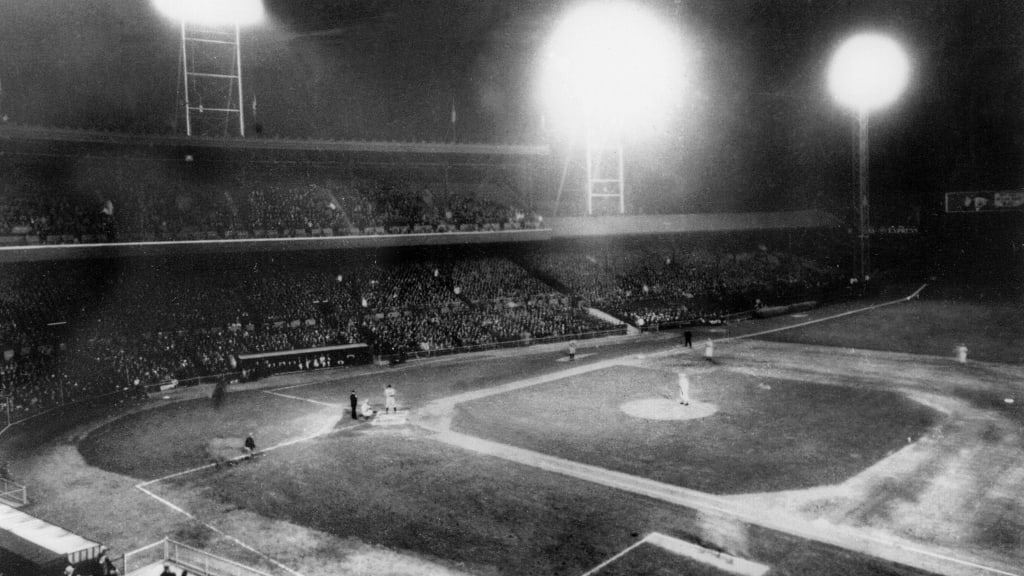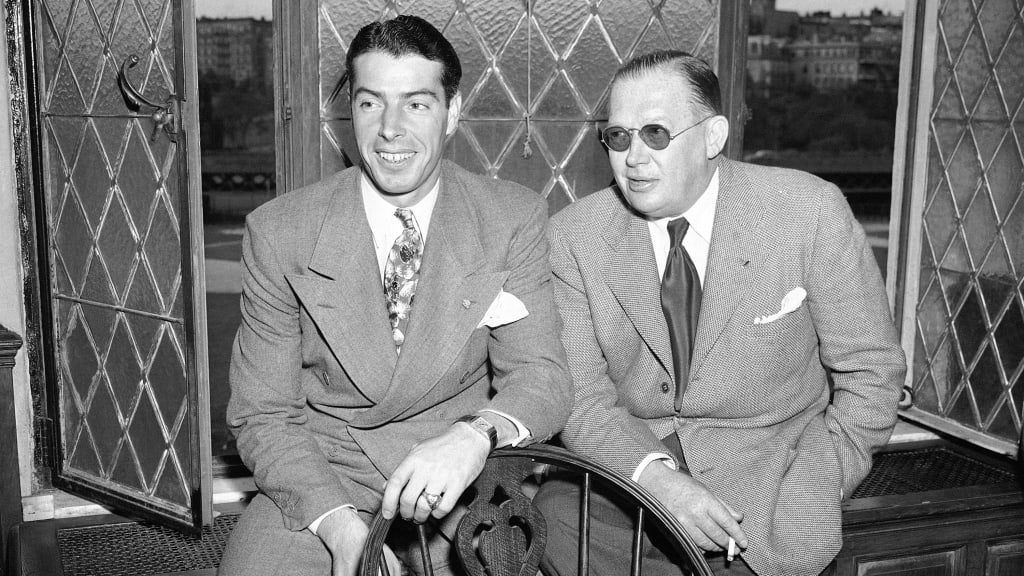
There was a World Series atmosphere in Cincinnati on May 24, 1935.
No, the Fall Classic had not been suddenly rescheduled for the spring. And a midseason matchup between the Reds and the visiting Philadelphia Phillies was not the source of the excitement. After all, these two teams had spent the previous decade often floundering near the bottom of the National League.
Whatever would occur inside Crosley Field on this chilly evening was secondary to what loomed above the field. Specifically, more than 600 1,500-watt lamps that would usher in a new era of baseball -- with a little help from the president of the United States.
This is the story of the first night game in AL/NL history.
Desperate times
Let’s be clear: Night baseball was far from unprecedented by 1935. Thomas Edison patented his first incandescent light bulb in 1879, and there was a baseball game played under artificial light the following year. Electricity illuminated numerous exhibition games throughout the early years of the 20th century, including one in Cincinnati in 1909.
The first Major League night game was staged by the Kansas City Monarchs of the Negro Leagues in 1930. Dozens of Minor League teams were playing under the lights by 1935; the Troy Daily News in Ohio called the acceptance of night games “the savior of Minor League ball” amid the financial pressures created by the Great Depression.
Larry MacPhail had seen firsthand how night baseball could be a boon for the sport. A bold and sometimes brash businessman, MacPhail helped financially revive the Columbus Red Birds, the Double-A affiliate of the St. Louis Cardinals, with crowd-pleasing promotions -- including night games -- while serving as the Red Birds’ president during the early ’30s. However, MacPhail’s personality often led to clashes with Cardinals general manager Branch Rickey and in 1934, MacPhail left to become the Reds’ general manager under new owner Powel Crosley Jr.
The Cincinnati Reds during this time were not good. They finished at the very bottom of the eight-team National League for the fourth straight year by the close of 1934. They had not finished higher than fifth place since 1926. The poor product on the field inevitably led to low interest from the populace. According to Baseball-Reference, the Reds drew fewer than 1,500 fans in at least 14 of their 77 home games that season.

The cash-strapped club needed a lifeline. MacPhail knew he had a tried-and-true answer to some of the Reds’ financial woes. Night games allow fans to attend games they otherwise couldn't due to the demands of their jobs or school. But it would take a lot of convincing in order to upend the orthodoxy of daytime baseball.
For the first 60 years of its life, organized baseball was illuminated by the sun and only the sun. So when MacPhail arrived at the National League’s offseason meeting and suggested that games be played after sundown, his idea was met with plenty of blowback.
Some players thought MacPhail’s proposal would present a much too radical change to their daily routine. Perhaps the lights would be too intense and affect their eyes, or not intense enough to light up a Major League stadium for the duration of the season.
Others, such as Washington Senators owner Clark Griffith, dismissed the idea out of hand. He called night baseball a “poor substitute” for the daytime game and said the air at night wasn’t as fresh as during the day.
“There is no chance of night baseball ever becoming popular in the bigger cities,” Griffith added. “People there are educated to see the best there is and will stand for only the best. High-class baseball cannot be played under artificial light.”
Commissioner Kenesaw Mountain Landis once told MacPhail that there will never be an AL or NL night game during either of their lifetimes. However, Landis did eventually cave to MacPhail’s request.
The Reds would be an AL/NL guinea pig of sorts. They would be the only team to play at night during the 1935 season. They would play only seven such games. The first was scheduled for Thursday, May 23, vs. the Phillies at 9 p.m. ET. Landis agreed to throw out the game’s first pitch.
The ‘experiment’ begins
By May 23, the Reds and Phillies were a combined 14 games under .500 and sitting in sixth and eighth place, respectively, in the National League. Newspapers around the country referred to the game as a “unique experiment” and a “novelty.” But MacPhail and Crosley were determined to put on a spectacle befitting of a World Series game.
The club spent $50,000 -- more than $1 million today when you adjust for inflation -- to construct a lighting system that contained 632 floodlights, each beaming out 1,500 watts. According to the Associated Press, the team demanded “lighting twice as brilliant as that of any other ballpark in the country” and stated that “it will be possible to read print four blocks from the center of the glare” once the lights are turned on.
Drum and bugle corps would entertain fans outside Crosley Field and then march from the center-field wall to home plate prior to the game. A fireworks display would follow. Baseball dignitaries such as Landis, NL president Ford Frick and AL President Will Harridge as well as the governor of Ohio and mayor of Cincinnati would be in attendance. And none other than President Franklin Roosevelt would help turn on the lights by pressing a key switch from the White House at 8:30 p.m, 30 minutes prior to first pitch.
The Reds played 15 home games prior to May 23 and averaged a little less than 7,000 fans per game. Prior to the big night, team officials said 12,000 tickets had already been reserved and a crowd of 30,000 people was expected.
“Night baseball is more than a novelty,” MacPhail told The Dayton Daily News. “The people of our town will be crazy for it, because it gives them a chance to watch a game outside of working hours. Wait and see.”
Wait they would. The skies over Crosley Field didn’t cooperate with the big plans as a consistent drizzle and cold temperatures throughout the morning and afternoon led to the decision to postpone the game until the following day.
MacPhail wired one of Roosevelt’s secretaries to ask if the president could still participate in the festivities despite the delay. A return message was received within minutes, signed by Roosevelt: “Am sticking with you. Will be glad to do my part tomorrow night.”
Game night
The low temperatures lingered into Friday, and Landis was unable to keep his commitment due to an illness, but that did little to quell the electricity in the air over, well, electricity.
At 8:30 p.m., Roosevelt pressed a gold telegraph key from Washington, D.C., sending an electric pulse that traveled about 500 miles over telegraph wires to a signal lamp near first base. Once MacPhail saw the signal, he flipped a switch, and everything – and everyone – lit up.
“What a roar went up,” Reds starting pitcher Paul Derringer told the Cincinnati Enquirer. “It was a thrill to hear those fans.”
Stadium usher Ralph Ploehs added that the fans expressed “utter joy” once the field was covered in light.
The game was played in a brisk 95 minutes as the Reds prevailed, 2-1. Derringer, the Reds’ ace who made his first of six All-Star teams later that season, went the distance. He scattered six hits and retired the final 12 batters he faced. All three runs were scored on RBI groundouts. When any ball was hit into the air, it “stood out against the sky like a pearl against dark velvet,” the Enquirer’s James T. Golden eloquently wrote.
The biggest highlight on the diamond occurred in the top of the sixth inning when Reds center fielder Sammy Byrd raced down a long drive by Phillies first baseman Dolph Camilli and hung onto the ball as he crashed into the unpadded, cement wall in center. Despite banging up one of his knees, Byrd stayed in the game and received rousing cheers from the Cincinnati faithful for his pivotal catch.
Fifty years later, Camilli told the Cincinnati Enquirer that he never liked day baseball, but you would be hard-pressed to find anyone else who came out of Crosley Field unimpressed with what was on display.
It was hailed by the Associated Press as a “great success.” Harridge stated his enjoyment of the game to United Press and called it “the greatest spectacle modern baseball has offered in several years.”
And, as told to the Akron Beacon Journal, the game even solved a marital issue for Gwen Martin and her husband, George: “My husband always argued with me because he had to work in the daytime while I could come to the games. Now if they keep on having night games, we can come and then George can’t squawk so much. Ain’t that right, George?”
“Yeah!” he responded.
Aftermath
The final attendance of 20,422 fell short of MacPhail’s goal. The cold weather was blamed for possibly keeping that number down, but the “experiment” still proved him right: Night games can be successful in the American and National Leagues.
The Reds played eight home games in front of at least 19,000 fans during the 1935 season. Five of those eight games came with the lights on. That included a walk-off win over the Cardinals on July 31 with a season-high 30,001 present.
Among the three exceptions? The Reds' Opening Day game on April 16, and a matchup vs. the Boston Braves on May 26. Two days after Cincinnati experienced the first night game, it welcomed Babe Ruth to the Queen City for the first time in his storied career. The aging Bambino went 0-for-4 with three strikeouts. Ruth announced his retirement one week later.
Other franchises followed the Reds' lead, slowly but surely. The next team to host a night game was the 1938 Brooklyn Dodgers, under the watch of their new general manager, Larry MacPhail. The Reds were the visitors for the June 15 contest, which holds a place in baseball history as the night when Cincinnati starter Johnny Vander Meer twirled his second consecutive no-hitter.
MacPhail spent the next decade split between the front offices of the Dodgers and Yankees before leaving the sport behind in 1947. Lauded as one of baseball's greatest innovators, he was inducted into the Hall of Fame in 1978, three years after his passing.
The American League’s first night game featured the Philadelphia A’s besting Cleveland on May 16, 1939. Griffith finally saw the light on May 28, 1941, when his Senators played the Yankees.
The first World Series night game took place in 1971, and all Fall Classic games since 1988 have been held without the sun’s help. That same year saw the Cubs become the final franchise established before the Expansion Era to welcome the night. In a slight bit of baseball symmetry, that game on Aug. 8 was halted and eventually postponed due to poor weather and didn’t occur officially until the next night.
Today, 88 years after the first one, about two-thirds of all AL/NL games are played under the lights.
